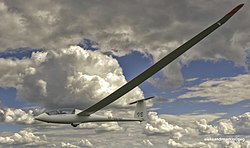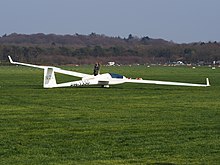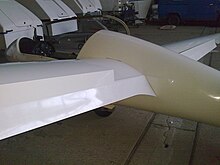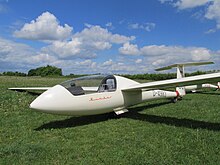Schempp-Hirth Nimbus
| Schempp-Hirth Nimbus | |
|---|---|

|
|
| Type: | Racing and open competition class glider |
| Design country: | |
| Manufacturer: | |
| First flight: |
1969 |
| Production time: |
1971 -? |
Schempp-Hirth Nimbus is a glider designed by Klaus Holighaus . The manufacturer is Schempp-Hirth in Kirchheim (Teck) .
With the exception of the Mini-Nimbus, all Nimbus types have a wingspan of more than 20 m, so they fly in Open Class . The Mini-Nimbus, on the other hand, flies in the racing class.
Versions
nimbus
For the prototype of the Nimbus, Holighaus used the fuselage of the open-class Cirrus and a similar tail unit, but a completely new, three-part wing with a wingspan of 22 meters. The prototype first flew in 1969. Only one aircraft of this type was built.
The effect of the rudder on this aircraft was not sufficient. Even if the pilot gave full aileron and rudder, it continued to fly straight for a few seconds before suddenly falling into a steep turn. There were no spoilers , so it was extremely difficult to land the plane. It was damaged several times like this. However, the aircraft offered outstanding gliding performance for the time, with a best glide ratio of 1:51 at 90 km / h and a lowest rate of descent of only 0.43 m / s.
George Moffat (USA) flew the Nimbus in 1970 at the World Championship in Marfa , Texas . Despite major handling problems, he was able to achieve first place.

Nimbus-2
The Nimbus-2 first flew in April 1971. It was built through most of the 1970s and was only roughly based on the first Nimbus. The Nimbus-2 was ultimately a completely new glider with many improvements. The wing was shortened to 20.3 meters and built in four parts to facilitate assembly and transport. He also got Schempp-Hirth airbrakes on the top of the wing.
The first 132 Nimbus-2 had a T-tail with the pendulum elevator of the Standard Cirrus . The later Nimbus-2b got a T-tail unit with a dampened elevator. The Nimbus-2c got a new type of airbrake system combined with the flaps, there was also a lighter version of this series (recognizable by the black instead of red "C" in the fuselage lettering) with wing spar straps with carbon fiber and with a higher maximum take-off weight. By 1979 over 230 Nimbus-2, -2b and -2c were built. A heavily modified single piece with a 23.5 m span was called Nimbus-2CS and was used to test the concept for the successor Nimbus-3. This unique piece is still registered today (as of August 2012) and is currently located in Great Britain. The Nimbus-2M was developed as a motor glider variant, this had a fold-out engine (Hirth engine 50 HP) and was self-launching.
The Nimbus-2 was successful in the competition. The world championship in the open class was won twice, several records were flown. Bruce L. Drake, David Speight and SH Georgeson set a world record in New Zealand in 1978 in target flight as well as in open distance with 1,254 km.
Mini nimbus
The Mini-Nimbus is a high-performance glider of the 15-meter class / racing class from the manufacturer Schempp-Hirth in Kirchheim (Teck). During this time, Klaus Holighaus managed two glider manufacturers: Schempp-Hirth Flugzeugbau and Glasflügel . He was able to use the wings he developed for both the Mini-Nimbus and the 303 Mosquito glass wing . The hull was adopted and modified from the Schempp-Hirth Cirrus. The first flight was in September 1976, while series production began in 1977. The Mini-Nimbus HS-7 (Holighaus / Schempp-7) is made entirely of GRP, while the Mini-Nimbus C partially uses carbon fibers in the wings and the horizontal stabilizer, which made it lighter. It was offered with a pendulum tail unit and later with a damped tail unit. With a glide ratio of 42: 1 at 105 km / h, the Mini-Nimbus is roughly on par with other racing-class aircraft of its time, or somewhat behind the somewhat "faster" ASW-20. With the lowest possible payload, its glide ratio is still 41: 1. The minimum sink rate is 0.57 m / s at 80 km / h. The maximum permissible speed is 250 km / h; the maneuvering speed is 200 km / h. It is also approved for simple aerobatics (looping, turn, etc.). The wing loading can be varied between 31 and 46 kg / m² (e.g. due to water ballast in the wings). The index of the Mini-Nimbus is 108. It has trailing-edge rotating flaps (a combination of spoilers and lowered flaps) that allow a steep approach, which can be helpful when landing outside . For normal approaches, the two spoilers can also be extended without lowering the flaps. When the flaps are lowered, they automatically return to the previously set curvature after the spoilers have retracted. The elevator trim is combined with the flaps, so the pilot only has to trim the aircraft once in flight using the trim lever - from then on the aircraft automatically trims tail-heavy with a positive curve and top-heavy with a negative curve. In flight, the Mini-Nimbus impresses with its excellent maneuverability and good circular behavior in thermals. With the pendulum control unit and the trailing edge rotary flaps, the aircraft is relatively demanding, especially in connection with its comparatively short fuselage length, as it reacts extremely sensitively to horizontal stabilizer control inputs. Like all aircraft with an undamped pendulum tail unit, it does not tend to self-stabilize when the control stick is released. When approaching for landing, it should be noted that a sudden retraction of the trailing edge rotary flaps causes a strong sag, which is why the touchdown point should only be corrected by the angle of attack, not by retracting the flaps. It is positive that additional pressure when the flaps are fully extended hardly results in a noticeable increase in speed, so that an approach that is too fast is not to be expected and comparatively steep approaches (“Sarajevo Approach”) are also possible. A total of 159 pieces of this type of aircraft were built until its production was discontinued in favor of the successor model Schempp-Hirth Ventus .
Nimbus-3
The Nimbus-3 was mainly made of carbon fiber reinforced plastic and got a new wing profile. The four-part wing had a wingspan of 22.9 m, which could be extended to 24.5 m, later even to 25.5 m, using clip-on wings. The outer wings are slightly modified Ventus wings. Yaw spoilers are attached to the clip-on wings, which support the rudder during large aileron deflections. The first flight was on February 21, 1981 by the designer Klaus Holighaus . The Nimbus-3T had a fold-out homecoming aid.
Nimbus-3 reached the first three places at the world championship in 1981, but with only twelve participants. In 1983 Nimbus-3 were in the first six places, and in 1985 the winner flew Nimbus-3.
The Nimbus-3D is the two-seater version. The first flight was in May 1986. The wings are swept slightly forward here. There was a self-starter version (Nimbus-3DM) and a version with a homecoming aid (Nimbus-3DT). The Nimbus 3D was initially built with a span of 24.6 m. There are span extensions to 25.6 m for the 3D and 3DT.
The Nimbus 3DM version was manufactured as a self-launching, two-seater motor glider with a Rotax 2-stroke engine 60 HP with a wingspan of 24.6 m.
Nimbus-4
The Nimbus 4 (first flight in 1990) is the current model and was derived from the Nimbus-3. The wingspan grew to 26.4 meters, the aspect ratio to 38.8. The fuselage is longer and has a larger rudder. The Nimbus is available in the single-seater version with homecoming aid (4T) and as a self-starter (4M). With the standard 26 l tank, “sawtooth” flights over 450 km are possible (or 750 km when using an additional wing tank). The fuselage tank alone is enough to carry out three to four self-launches at an altitude of 1000 m each. A refueling system integrated in the fuselage allows the installed tanks to be refilled with ease. The motor can be removed and installed with little effort and enables the NIMBUS-4M to fly at any time with the drive removed (and thus approx. 55 kg less weight). The gliding index is 124.
There is also a two-seater version Nimbus-4D as well as versions with turbo (4T or 4DT) or self-starter (4DM).
Nimbus-4D
The Nimbus-4D is a two-seater glider made of fiber-reinforced plastic and with a wingspan of 26.5 m (aspect ratio 39.1) is the largest series produced by Schempp-Hirth to date.
With its best glide ratio of ~ 60 and excellent slow flight and climbing performance, the Nimbus-4D is in no way inferior to comparable single-seaters, but has significantly improved flight characteristics. Rudder set-up and maneuverability give the impression of a much smaller two-seater. A result that could only be achieved through the extraordinary aerodynamic wing design, combined with sophisticated control kinematics.
Technical specifications
| Type | Nimbus 2 | Mini nimbus | Nimbus 3 | Nimbus 3D | Nimbus 4 | Nimbus 4D | Nimbus 4DM |
|---|---|---|---|---|---|---|---|
| Competitive class | Open class | 15 m FAI (racing class) | Open class | ||||
| Seats | 1 | 2 | 1 | 2 | |||
| Dimensions | |||||||
| length | 7.28 m
(7.33 m for 2c) |
6.41 m | 7.63 m | 8.62 m | 7.83 m | 8.62 m | |
| Wingspan | 20.30 m | 15.0 m | 22.9 / 24.5 / 25.5 m | 25.6 m
up to 24.6 m (3DM) |
26.4 m | 26.6 m | |
| Wing area | 14.41 m² | 9.86 m² | 16.28 / 16.7 / 16.9 m² | 17.02 m² | 17.86 m² | 17.96 m² | |
| Elongation | 28.6 | 22.8 | 32.2 / 35.9 / 38.4 | 38.5 | 38.8 | 39.1 | |
| Masses and payload | |||||||
| Empty mass | approx. 350 kg (2b), 315 kg (2c) | 235 kg | 396 (24.5 m) 408 kg (25.5 m) |
485 kg
595 kg (3DM) |
470 kg | 515 kg | 595 kg |
| Water ballast | 120-210 kg | 125 kg | 338 kg | 168 kg | approx. 300 kg | 80 kg | |
| Max. Takeoff mass | 580 kg (2b),
650 kg (2c) |
450 kg (GFK), 500 kg (CFK) | 750 kg | 750 kg
820 (3DM / 3DT) |
750 kg
820 (4M) |
750 kg | 820 kg |
| Wing loading | 29-40.3 kg / m² (2b) 28-45.1 kg / m² |
31-46 kg / m² | 29–46 kg / m² (22.9 m) 28–42 kg / m² (24.5 m) |
32.6-44.1 kg / m²
- 48.5 kg / m² (3DT / 3DM) |
30-44 kg / m² | 32.6-41.8 kg / m² | 37.6-45.7 kg / m² |
| Flight performance | |||||||
| Top speed | 220–250 km / h 270 km / h (2b / c) | 250 km / h | 270 km / h | 275 km / h | 285 km / h | 285 km / h (320 km / h) | |
| Maneuver speed | 160 km / h | 200 km / h | 190 km / h | ? | 180 km / h | ||
| Slightest sinking | 0.49 m / s | 0.57 m / s | 0.42 m / s at 75 km / h (24.5 m) | 0.48 m / s | approx. 0.38 m / s | ? | ? |
| best glide ratio | approx. 47 | 42 (flown) | approx. 58 (24.5 m) | approx. 57 | approx. 60 | approx. 60 | approx. 60 (110 km / h) |
Web links
- EASA-TCDS-A.063 (PDF; 111 kB) - Type certification of the Nimbus-4M





